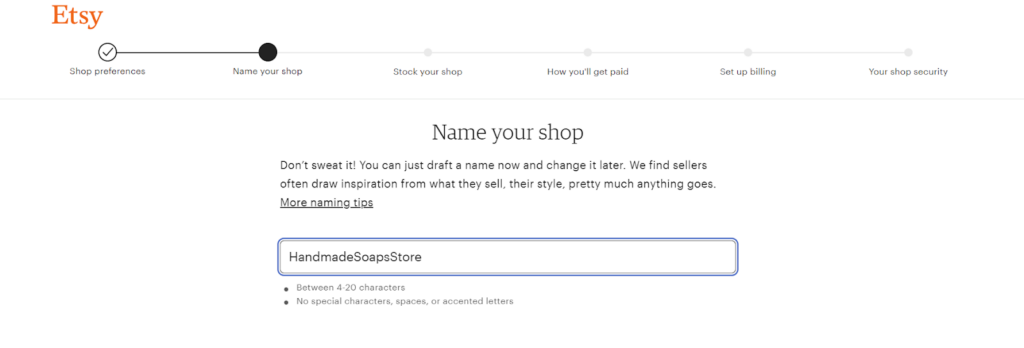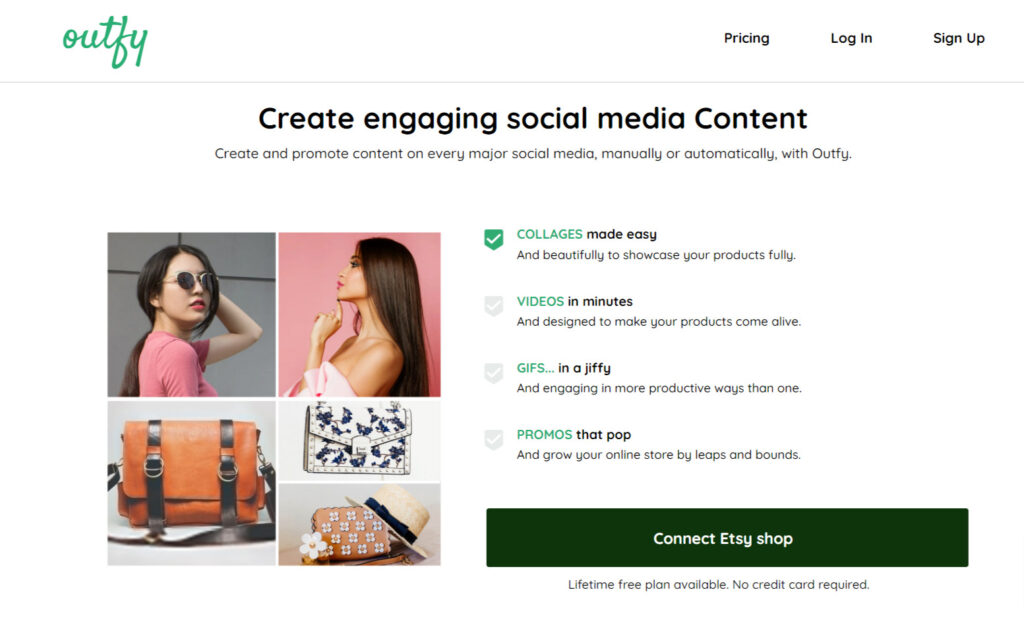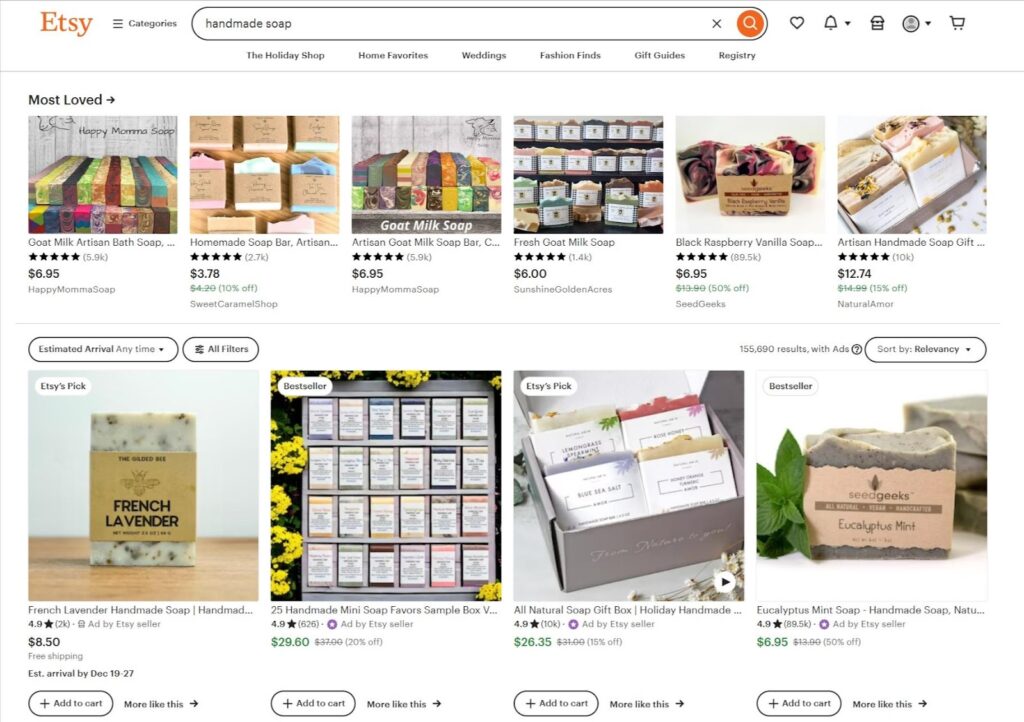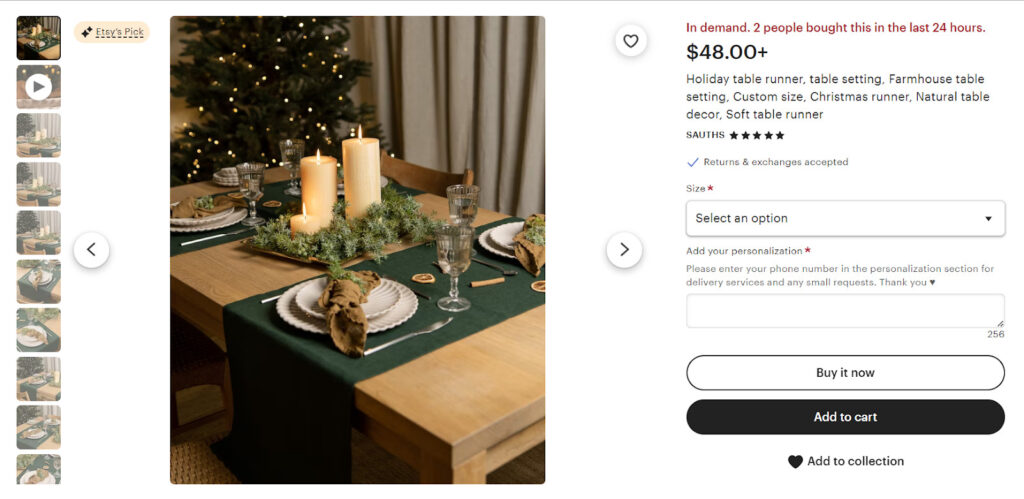
If you’re daydreaming about starting your own business and you love crafts, you’ve probably heard about Etsy—one of the biggest online marketplaces for handmade or vintage items and craft supplies.
Whether you want to earn extra bucks on the side or you want to invest your entire focus on starting an online business, with almost 500 million visits monthly, Etsy can be the perfect opportunity to get in front of an audience looking for unique items.
Etsy had 96.2 million buyers in 2023; over two million more than it did in 2022. To top it off, Etsy has a significant mass of loyal customers—40% of Etsy buyers are repeat customers, and 8.9% are “habitual buyers,” meaning consumers who make repeat purchases several times without the process of high involvement.
If you’re grappling with the question of how to start an Etsy shop, keep reading. In this article, we’ll take you through the steps of creating an Etsy shop, list the tools you need to jump-start your success, and share best practices to help you boost Etsy shop sales.
How to start an Etsy shop
Starting an Etsy shop is a simple and straightforward process. At each step, there are detailed instructions for the information you need to fill in. Don’t rush—make sure you go through all the steps and create the foundation of your Etsy shop. Here’s a step-by-step guide on how to do it.
#1: Create an account
If you’re just starting your Etsy journey, the first step is to create an Etsy account. This is a simple process where you need to add your email address, first name, and password. Once you register, you can open your Etsy shop by selecting “Sell on Etsy” from your account menu.

During this step, you can answer a few screening questions, such as what brings you to Etsy and if there is anything you’d like help with. Whether you are selling for the first time ever, or you want to expand your business by selling on Etsy, the platform can help you with guidance on how to make the most out of Etsy.
You can also choose different topics you want to get more resources on, such as deciding what to sell, choosing a name for the shop, selling online, or taking product photos.

#2: Enter shop preferences
Once you go through the screening questions, you can start building the foundations of your Etsy shop. First, you need to select basic preferences such as language, country, and currency. Be careful—the language you choose will be the default language you’ll use to describe your items. You can later add other languages, but you can’t change the default language.
The country refers to the location where your store is based. You can only choose from a list of countries where Etsy is available. Lastly, the currency you select is the one you’ll use to price your items on Etsy. Buyers will automatically see the prices in their local currency.

#3: Choose a name
If you’re not one of the sellers who already have the name figured out, you might find this step a bit overwhelming. Here’s where Etsy naming tips come in handy. According to Etsy’s guidelines, the name should have between 4 and 20 characters, with no special characters, spaces, or accented letters.
In case the name you have in mind is already taken, you can always add the words “shop” or “boutique.” You’ll notice that many of the Etsy shop names are descriptive, which means that sellers often draw inspiration from what they sell.
Another thing to keep in mind is the audience. Since selling on Etsy puts you in front of a diverse, global audience, it’s good to choose a name that will strike a chord with almost everyone. Last but not least, don’t worry too much. You can always change the name of your Etsy shop later.

#4: Create product listings
After you set up your shop preferences and choose a name, it’s time to stock your shop. During this step, you should take care of things such as:
- Photos and videos - Add up to ten photos to show your items using angle shots and detailed images, show the scale of the product, show a styled scene, or show the product in use. Etsy shares useful tips such as using natural light, showing the item being held, worn, or used, using a clean and simple background, showing product variations, etc. You can also add a 5 to 15-second video to bring the product to life.
- Listing details - In the next section, you should add details such as title, category, type of product, description, production partners, tags, and materials.
- Inventory and pricing - You should also define the price, quantity, and SKUs. Etsy does a great job of giving sellers directions throughout the process, for example, reminding them to factor in the costs of materials, labor, and other business expenses such as shipping in case the seller is offering free shipping.
- Shipping - In the shipping section, the seller should fill in shipping prices (Etsy has the option to calculate the shipping price based on the information sellers add in this section), origin ZIP code, processing time, what countries the seller will ship to, shipping services, item weight, and item size.
- Returns and exchanges - Product returns play an important role in e-commerce. You can choose from a predefined simple policy or create a custom policy. They can also create different policies for different items.
- Additional information - Besides the basic information, you can also add information such as available options and enable the option for personalization, allowing customers to request special features.

#5: Select payment methods
Once you create your product listings, you should select the payment methods. In this section, the seller specifies bank location and type of seller—individual or business. Based on that information, you can add personal information such as country of residence, first name, last name, date of birth, and taxpayer address.
Businesses, on the other hand, should enter the name of the legal entity, legal business address, state, business registration number, and employer identification number (EIN).

#6: Set up billing
The next step is setting up billing. This step is necessary as sellers need to add a credit card to be able to pay for their Etsy fees. There are three main fees that Etsy sellers encounter: listing fees, transaction fees, and payment processing fees (if they are using Etsy Payments). Additionally, there are auto-renew sold fees, multi-quantity listing fees, advertising fees, subscription fees, and private listing fees.
#7: Reinforce your shop security
During the final step, sellers can add two-factor identification to keep their shop extra safe. They can choose between SMS, phone, or authenticator app.
Essential tools to kick-start your Etsy shop and get more sales
Etsy is one of the most popular ecommerce sites in the world, but the competition is fierce. To stand out from the crowd, you need to go the extra mile and rely on additional tools to set up your Etsy shop for success. Let’s look at some of the essential tools you need.
Get repeated sales through email marketing
While Etsy offers a great opportunity to get in front of a massive audience, using a third-party platform still means that you’re renting your audience. With email marketing, you can decrease your dependence on marketplaces and regain control over your online business and your audience.
Using a tool like AWeber will allow you to set up email automation without the heavy lifting and effortlessly cross-sell, upsell, and follow up on abandoned carts. AWeber is the only email marketing software showcased by Etsy, and it fully integrates with the marketplace, keeping sellers compliant with Etsy’s Seller Policy.
Etsy is strict about email marketing, and according to its policy, you must allow customers to opt into your email list. With AWeber's integration, an opt-in email is automatically triggered after a purchase, building your contacts list with each new sale.
ArtTributeCo is an Etsy shop selling unique art designed accessories such as camera and guitar straps, dog collars, and personalized pet bag carriers. ArtTribute uses AWeber’s auto newsletter feature to inform customers of new product launches with automatically-triggered newsletters.

Promote your shop on social media
Sellers who use social media to promote their Etsy shop can dramatically increase their Etsy store visibility and get more sales. However, instead of posting manually, you can use a tool such as Outfy, which integrates with Etsy, to automate social media posts.
Once you connect your Etsy shop, Outfy lets you auto-post on all social networks, saving you time and effort. Using Outfy, Etsy sellers can easily create engaging social media content such as collages, videos, GIFs, and promos.

Optimize your Etsy shop for SEO
If you want to boost your chances of being seen, use the power of SEO to improve your shop’s visibility in search engine results for Google, Bing, and Yahoo, as well as Etsy search. Besides doing the basic things that will enhance your shop’s SEO, such as descriptive product titles, keywords, tags, product descriptions, and reviews, you can also rely on SEO optimization tools for better results.
Using tools such as eRank helps you discover product keywords that shoppers are searching for on Etsy, track competitors, and their daily sales, listing, and keywords they are using, and stay on top of trending items on platforms such as Etsy and Amazon, to get a sense of in-demand products.

Use Etsy advertising
Sellers who want to get an extra boost can use Etsy’s Promoted Listings to boost product visibility. The model is pay-per-click, and sellers pay so their products can show up at the top of the search results (marked with “ad”).
Ads can be shown on search and browsing pages across Etsy.com and the Buy on Etsy mobile application (including Etsy search, relevant category and market pages, and similar listings). Knowing that customers are more focused while browsing the first few pages, getting your products listed in the top results will help you get more eyeballs and, ultimately, more sales.

Best practices to boost Etsy shop sales
After you have started your Etsy shop and incorporated the necessary tools to enhance your shop's visibility, you have established the groundwork for a successful Etsy shop. However, your work doesn't end there. By following some best practices, you can ensure that your Etsy shop is set up for success.
Create high-quality product visuals
With the rise of ecommerce, the importance of visuals has grown significantly. The competition is intense, so Etsy sellers who want to stand out have to create stunning product visuals. Use the power of visuals to add context, show the product being used, and add visuals from multiple angles.
SAUTHUS is an Etsy shop for linen clothes, table linens, and linen bedding, renowned for its outstanding product visuals, which helps them capture customers’ attention while they are browsing through the Etsy product feed.

Capture customers’ email addresses and use automation
Customer retention is crucial for the success of your Etsy shop. Here’s where email marketing comes in handy. You can use email marketing to auto-send announcements when you add new products to your Etsy store and drive repeat sales automatically with behavior-based, personalized messaging.
With AWeber, sellers can choose from hundreds of email templates and pre-built automated campaigns. From setting up landing pages and email flows to welcome series and promotional campaigns, AWeber empowers you to promote your products and fuel sales.

Research competitors and offer competitive pricing
Selling on Etsy provides access to a large audience, but low barriers to entry lead to intense competition. To stay competitive, you have to understand what your competitors are offering in terms of products, prices, packaging, and shipping.
Once you understand your competitors’ positioning, you can differentiate by adding value, such as free shipping, offering a bundle, or special coupon codes.
Build a delightful customer experience
Whether you want to start an Etsy shop as a side hustle or you want to dedicate yourself to it full-time, you have to understand that creating an exceptional customer experience is a prerequisite for success.
While there’s no universal definition of a delightful customer experience, things like answering questions timely, responding to customers’ feedback, keeping customers informed about the latest updates through email, thanking customers for their purchase, and personalizing customer experience based on previous purchases can help you meet (and exceed) customers’ expectations and keep them coming back.
Encourage reviews and leverage UGC
Online reviews are the digital equivalent of a friend’s recommendation in the physical world. Nine in 10 consumers say they consider reviews when making a purchase decision, according to Power Reviews. The reason is simple—products with more reviews give customers a sense of confidence that they are making the right decision.
Etsy gives customers the opportunity to filter search results by top customer reviews, which means that products with more reviews can get better visibility and, as a result—more sales.
The luxurious bath gift box from Herbana Cosmetics is a great example of how getting more customer reviews gets you in the top search results, boosting your chance of getting more customers.
By encouraging customers to leave product reviews, not only will you get a better position in search results, but you can also leverage user-generated content, such as customers’ quotes and photos, to promote your products across different channels.

FAQs on starting an Etsy shop
1. How much does it cost to start an Etsy shop?
Starting an Etsy shop is free of charge. However, there are three basic fees for selling items, which include a listing fee, a transaction fee, and a payment processing fee. The cost to publish a listing to the Etsy marketplace is $0.20. Additionally, there is an advertising fee for sales that come from Offsite Ads.
2. Do I need a business license to sell on Etsy?
According to Etsy's seller policies, sellers are not required to have a business license to sell on their platform. However, make sure to do additional research and check your local and state laws to comply with regulations in your area.
3. Is it worth it to sell on Etsy?
Etsy is one of the easiest ways to start selling your handmade or digital products online and get them in front of a large audience. Following additional best practices such as creating stunning product visuals, using email marketing to get repeat purchases, encouraging customers to leave product reviews, and building a delightful customer experience can help sellers stand out and sell more.
Boost Etsy shop sales with email marketing
There you have it—a step-by-step guide on how to start an Etsy shop, essential tools to jump-start your success, best practices to get more sales, and answers to the most frequently asked questions on having an Etsy shop.
If you’re looking for ways to boost your Etsy shop sales from the get-go, using a tool like AWeber will help you maximize your sales with email marketing. From automatically generated newsletters with the latest products to welcome email sequences and promotional campaigns, email marketing will bring back control over when and how you communicate with your customers and visitors.
Ready to boost your Etsy shop sales with email marketing? Get started with AWeber today—it’s free!
The post How to start your Etsy shop: A step-by-step guide appeared first on AWeber.
from AWeber https://ift.tt/4l0mED7
via IFTTT
No comments:
Post a Comment